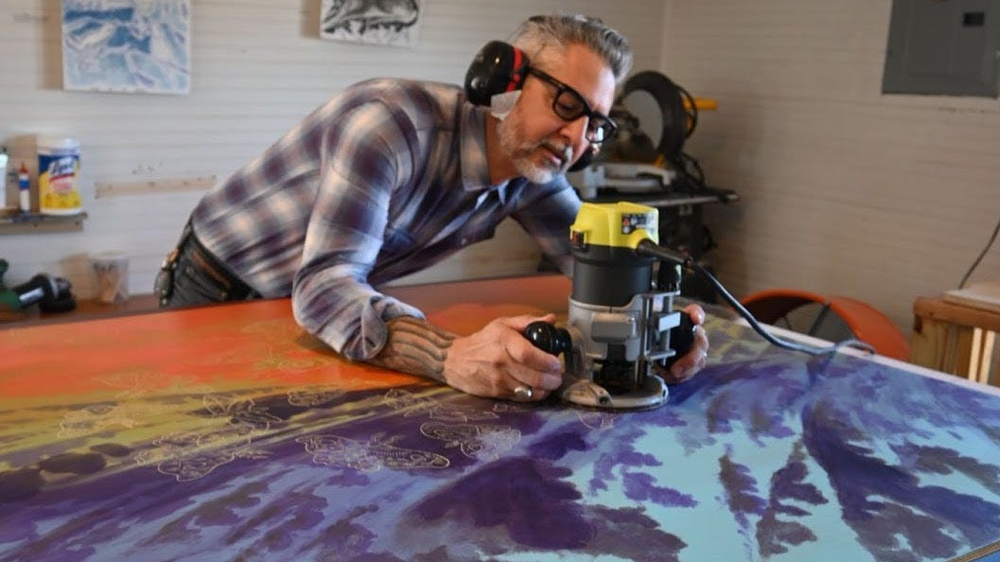A new exhibit, The Gods Wait to Delight in You…C.B., featuring Texas borderland artist Ricky Armendariz opened recently at Ruiz-Healy Gallery in New York City’s Uptown Manhattan location. Known for his illuminating portrayal of the changing Western environment, Armendariz’s new work is a visual reinterpretation of the borderlands. Armendariz has been creating art for nearly 25 years, and while his first solo show in New York City is a breakthrough for him, it is also a moment when Latino art can be appreciated in one of the major world art capitals.
Armendariz’s art career began when he completed his Master of Fine Arts studies at the University of Colorado, Boulder. As an undergraduate student at the University of Texas San Antonio in the early 1990s, this Latino art
major sensed an attraction to creating art, even though his initial interests included art history and art therapy. Upon finishing his graduate studies at Boulder, Armendariz returned to UTSA as a member of the Art Department in 2004.
In his initial years as an artist, Armendariz relied on his personal borderland experiences as a way of expressing the subjects of interest to him. He professes strong identification with both American and Mexican cultures, and he is especially fascinated with the people and animal life of the Rio Grande, the Mexican Sierras, and the arid landscape of West Texas. Gallery owner Dr. Ruiz-Healy aptly explains that throughout Armendariz’s career, the “animal world has been a significant source of inspiration, representing emotions, conflicts, personal experiences, and more.”
Armendariz acknowledged a passion for Western Romanticism in his early works. The American landscape and the hybridization of Mexican, American, and indigenous cultures informed much of the content of his work. Examples of this romanticism are his large wood-carved paintings of a curandero [faith healer] and the buffalo of the western plains. His art has also included an abundant portrayal of birds, rabbits, bears, buffalo, and
coyotes carved into birchwood, all representing the past and present of his life in the Texas-Mexico borderlands.
Armendariz’s favorite medium is birchwood panels. He works with power tools to carve and burn his images into the surface of the wood as a base for his paintings and prints. He explained to art historian Teresa Eckmann that he prefers images “that have a cultural, biographical, and historical lineage.” The new show in New York City features work with unique oil applied on carved Baltic birch reliefs.
When Armendariz won an artist in residence award in 2013 to study and work at Kunstlerhaus Bethanien Berlin, Germany, he considered himself a Western romanticist. His work beamed with what he called the new and old West, American culture, and the “iconography of his ancestral past.” But much has changed in the borderlands of his upbringing since that Berlin assignment. Today the border is buzzing with commerce and overflowing with immigrants from all regions of the globe. Armendariz is among the borderland artists attempting to capture the tension and complexities of migration in their artwork.
In portraying migration apocalyptic movements, Armendariz substitutes nature’s four-legged animals, birds, bees, and butterflies as representatives of human migrants. He assigns animal-human symbolism and connectivity to affix human cultures across time. In his own words, Armendariz affirms that many works in the Ruiz-Healy exhibition are “tied to our current state of the border, the exodus of people from one country to another, looking for a better life.”
The Ruiz-Healy catalog notes that the archetypical animals, coyotes, rabbits, owls, and birds are “enigmatic and reused and, in turn, recontextualized by the artist, becoming antagonists and protagonists.” Gallery owner Dr. Ruiz-Healy explains that attribution of human characteristics or human behavior to animals in motion “serves as stand-ins for the metaphorical and literal idea of the movement of people, whether forced or voluntary.” Armendariz is also often drawn to conceptual themes “involving power dynamics and sentimental love, as well as passionate and explosive love.”
Armendariz captures the common folks of the border in three paintings: Novios, Scorpio; Novios, Taurus; and Novios, Sagittarius. Based on the modest clothing, the novios [lovers] appear to have working-class roots. Armendariz refers to the three different signs of the horoscope in these paintings. He has a deep interest in astrology and a strong belief that fate and chance may be determined by when one is born. Armendariz expresses fascination “that many different cultures have a belief system that directly aligns with when you’re born, what hour you’re born, and how that directly affects the trajectory of your fortune or your misfortune.”
The Armendariz exhibit allows viewers to better
understand the Borderlands, an extensive region in which the Rio Grande separates the United States from Mexico along an 800-mile path from El Paso to Brownsville. Armendariz explained to art historian Eckmann that his work is “like the Southwest, something that looks like where I came from, a Bordertown.”
Latino artists are spearheading an art movement that more accurately defines the borderlands. Their art contributes to an understanding of the complex policies concerning the region’s migration, social class, and identity issues. The Ruiz-Healy Galleries, with exhibit space in San Antonio, Texas, and New York City, stand out as one of the few American art galleries to bring greater comprehension of the U.S.-Mexico borderlands, borderland experiences, and the expansive talent of these artists.
Ruiz-Healy Gallery Features Latino Artist Ricky Armendariz In New York City









